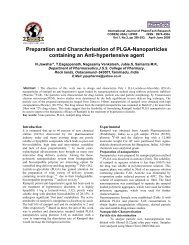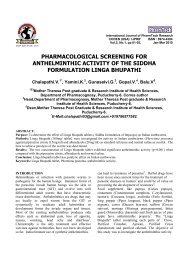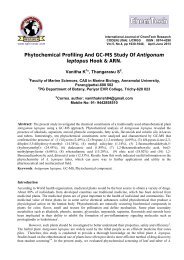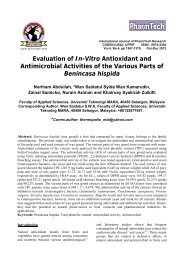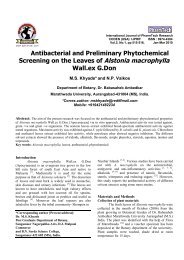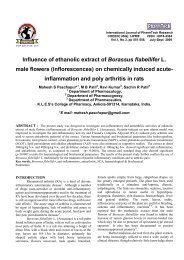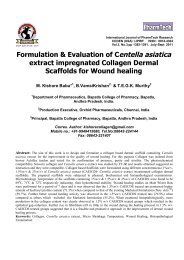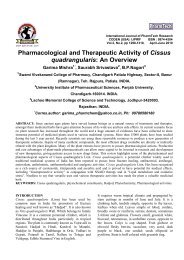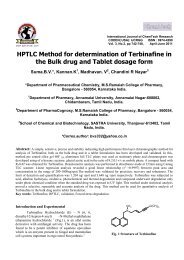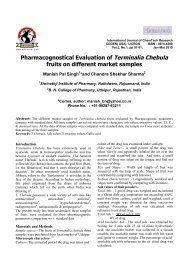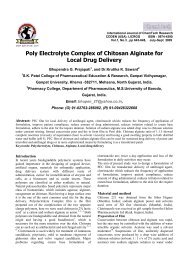epoxidation of wild safflower (carthamus oxyacantha) - Research ...
epoxidation of wild safflower (carthamus oxyacantha) - Research ...
epoxidation of wild safflower (carthamus oxyacantha) - Research ...
Create successful ePaper yourself
Turn your PDF publications into a flip-book with our unique Google optimized e-Paper software.
Pawan D. Meshram et al /Int.J. ChemTech Res.2011,3(3) 1160<br />
Figure 8: Effect <strong>of</strong> the hydrogen peroxide to ethylenic unsaturation molar ratio on the relative conversion to<br />
oxirane. Conditions: Temperature, 60°C; acetic acid to ethylenic unsaturation molar ratio, 0.5:1; catalyst<br />
loading, 20 wt. % <strong>of</strong> oil; stirring speed, 2000 rpm<br />
Effect <strong>of</strong> hydrogen peroxide to ethylenic<br />
unsaturation molar ratio<br />
The effect <strong>of</strong> different mole ratios <strong>of</strong> H2O2-to-ethylenic<br />
unsaturation on rate <strong>of</strong> oxirane formation and iodine<br />
conversion was studied by carrying out a series <strong>of</strong><br />
reactions (Table-5). As seen in Fig.8 the reaction rate<br />
increased with an increase in concentration <strong>of</strong> H2O2 in<br />
the reaction. However; although the maximum<br />
conversion (91.2 %) <strong>of</strong> double bonds to epoxide rings<br />
was achieved with 2.0 mole <strong>of</strong> H2O2 concentration<br />
after 5 hours, it also tend to destroy the epoxy rings<br />
when reaction was continued further. For a lower H2O2<br />
dosing <strong>of</strong> 0.5 and 1.0 mole, the maximum oxirane<br />
level and initial <strong>epoxidation</strong> rates were significantly<br />
lower as compared to that obtained with use <strong>of</strong> 1.5<br />
mole H2O2. Moreover, the epoxy rings formed for<br />
1.5:1 mole ratio <strong>of</strong> H2O2 -to-ethylenic unsaturation<br />
shows excellent stability. Therefore, the optimal<br />
hydrogen peroxide-to-ethylenic unsaturation molar<br />
ratio was found to be 1.5 mol/mol, with a relative<br />
conversion to oxirane <strong>of</strong> 86.5% and iodine value<br />
conversion <strong>of</strong> 87.2% after 8 hours <strong>of</strong> reaction.<br />
Fourier transform infrared (FTIR) spectroscopy<br />
analysis<br />
Shimazdu FTIR-8400 spectrometer was used for<br />
monitoring the disappearance <strong>of</strong> double bonds and<br />
formation <strong>of</strong> epoxy groups during the reaction by<br />
qualitative identification <strong>of</strong> main signals. Only two<br />
spectra are analyzed: the raw oil, WSO and epoxide<br />
adduct, EWSO (Fig.9A & 9B, respectively), to show<br />
the changes in their functional groups. For WSO the<br />
characteristic peaks at 3008 cm -1 , 1650 cm -1 and<br />
721cm -1 are attributed to the stretching vibration <strong>of</strong> the<br />
double bonds: =C-H, C=C, cis-CH=CH, respectively.<br />
S. Hernandez-Lopez et.al. [26] reported the diminution<br />
<strong>of</strong> peak, C=C-H stretching at 3020 cm −1 after<br />
<strong>epoxidation</strong> reaction, which supports our study where<br />
the almost complete disappearance <strong>of</strong> double bonds<br />
band at 3008 cm −1 at 60 0 C after 8 h was observed. This<br />
confirms that almost all the C=C-H had taken part in<br />
the <strong>epoxidation</strong> reaction. Also, there is decrease in the<br />
intensity <strong>of</strong> the other important unsaturated bond<br />
signals in comparison with the unreacted oil, giving<br />
reliable support <strong>of</strong> its chemical transformation to an<br />
oxirane ring. The presence <strong>of</strong> new peaks in the FTIR<br />
spectrum <strong>of</strong> WSFO at 831 cm −1 , attributed to the<br />
epoxy group, confirmed the success <strong>of</strong> the <strong>epoxidation</strong><br />
reaction <strong>of</strong> WSO. Vleck and Petrovic [27] reported the<br />
presence <strong>of</strong> epoxy groups at 822–833 cm −1 , which<br />
agrees well with this study. The other new peak at the<br />
3470 cm −1 was attributed to the hydroxyl functional<br />
group, derived from the epoxy functional group via<br />
partial epoxy ring opening reaction. The intensity <strong>of</strong><br />
the 3470 cm −1 band indicated the extent <strong>of</strong> hydrolysis<br />
<strong>of</strong> EWSO. The epoxy ring opening reaction could<br />
occur either by acid catalysis in the presence <strong>of</strong> water<br />
associated with aqueous solution <strong>of</strong> H2O2 used [28] .<br />
The hydrolysis <strong>of</strong> the ester groups during <strong>epoxidation</strong><br />
reaction in oils is the main side reaction. The band<br />
corresponding to carboxylic acid group is located at<br />
1650 cm -1 and is usually very intense even at low<br />
carboxylic group concentration [29, 30] . In case <strong>of</strong><br />
hydrolysis, a carboxylic acid functional group is<br />
formed and this carbonyl group will appear near but<br />
differentiable <strong>of</strong> the ester carbonyl stretching C=O in<br />
the glyceride moiety at 1744 cm -1 . However; in the<br />
course <strong>of</strong> the <strong>epoxidation</strong> reaction carried out in our



